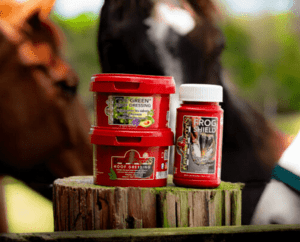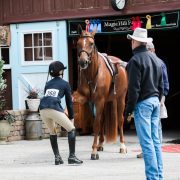Clipping How-Tos: Get the Details Just Right, Presented By Wahl

It’s one thing to be talented enough to body clip with no jarring blade lines. It’s another skill entirely to master all the little details, from the perfect bridle path to the base of the tail, and every little nook and cranny along the face.
Heels Down Mag caught up with Morgan Osbaldeston, the professional groom behind CLIPclop Body Clipping in north Georgia, to learn her tricks of the trade.
“I am usually clipping other people’s horses for a variety of barns. Each owner and each trainer will have their own personal preference for how the details are handled,” Morgan explained.
Bridle Path
Morgan’s personal preference for trimming a bridle path is to be about the width of the blade, which is about an inch-and-a-half to two inches.
“I like for the crown piece of the bridle to be nicely nestled between the forelock braid and the first braid on the neck,” she described. “For horses who wear cribbing straps, I make it a bit wider so their collar can sit comfortably behind their halter.”
Morgan does accommodate the needs of different disciplines, too. Her western riding clients generally prefer a more old-school approach, she said, of laying the ear back.
“I have sales barn clients who don’t do bridle paths at all – (it’s) too much to keep up with, not knowing how different sales horses are about clippers near their ears and no easy way to do a quick tidy on some of them,” Morgan said.
But overall, how far back the bridle path goes depends on the horse’s forelock.
“My ‘standard’ is to have it start right in line with the back of the ear. There’s usually a natural crease in the horse’s topline there,” she said. “For a horse with a skimpy forelock, I will usually push it back about half an inch so that some mane can be pulled forward into the forelock. A horse with a very thick, heavy forelock (specifically, ones who will be braided), I will bring it a little farther forward.”
Base Of The Tail: Round or Triangle?
Morgan admits she’s a triangle girl all the way.
“My triangles have a little bit of a curve to their sides. I think it contours the body nicely and looks more natural than a strictly angular triangle,” she explained.
“Most horses you can find the musculature on the sides of the tail bone and it creates an easy crease to follow. Keep in mind that the triangle on the dock can create optical illusions to make a hind end look bigger or smaller,” she offered.
The Tiny Details Of The Face
Morgan is right-handed, so she begins by closing the horse’s eye with her left thumb.
“Some horses lean into you, because their faces are itchy, so I kind of block the lean with my left forearm,” she described. “If you are clipping the lower-eye whiskers, point your blades down, away from the eyeball. You can also switch to a smaller clipper at this point, which will have less vibration and noise and should help minimize sudden movements. Keep in mind you will still want your blade length to match what you used elsewhere.”


